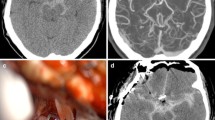Abstract
Background
Subdural fluid collections (hygromas and effusions) in adults are usually seen following head trauma or overdrainage of cerebrospinal fluid (CSF) after CSF diversion procedures. We report an unusual case of subdural fluid collection that developed spontaneously 5 days after an aneurysmal subarachnoid hemorrhage (SAH). This patient neither had permanent CSF diversion procedure nor history of significant head trauma during her clinical course.
Methods
This study is a Case report of the patient suffering from an SAH.
Results
A 71-year-old woman suffered an SAH from a ruptured right-sided posterior communicating artery aneurysm. Computed tomography (CT) demonstrated diffuse SAH and signs of early hydrocephalus that did not require treatment. The aneurysm was treated with endovascular coil occlusion without any complications. Throughout her hospital course, she remained alert without neurological deficits. A large subdural fluid collection was discovered incidentally during a routine CT scan of the brain 5 days after the SAH. The patient remained asymptomatic; therefore, the collection was treated conservatively. It resolved spontaneously at five days after the initial diagnosis.
Conclusion
Subdural fluid collections following SAH can occur as a result of head trauma, external hydrocephalus, or as a treatment complication of CSF shunting and craniotomies. It is critical to differentiate simple hygromas from external hydrocephalus since their response to CSF diversion is entirely different.


Similar content being viewed by others
References
Kawaguchi T, Fujita S, Hosoda K, Shibata Y, Komatsu H, Tamaki N. Treatment of subdural effusion with hydrocephalus after ruptured intracranial aneurysm clipping. Neurosurgery. 1998;43:1033–9.
Tzerakis N, Orphanides G, Antoniou E, Sioutos PJ, Lafazanos S, Seretis A. Subdural effusions with hydrocephalus after severe head injury: successful treatment with ventriculoperitoneal shunt placement: report of 3 adult cases. Case Rep Med. 2010;2010:743784.
Mitra S, Ghosh D, Pathak A, Kumar L. Bilateral subdural effusion and subcutaneous swelling with normally functioning csf shunt. Neurol India. 2001;49:178–81.
Liu YG, Xu CJ, Zhu SG, et al. Traumatic subdural hydroma developing into chronic subdural hematoma. Chinese journal of traumatology = Zhonghua chuang shang za zhi/Chinese Medical Association. 2004;7:188–90.
Rabe EF, Flynn RE, Dodge PR. Subdural collections of fluid in infants and children. A study of 62 patients with special reference to factors influencing prognosis and the efficacy of various forms of therapy. Neurology. 1968;18:559–70.
DE Haines, Harkey HL, al-Mefty O. The “subdural” space: a new look at an outdated concept. Neurosurgery. 1993;32:111–20.
Donaldson JW, Edwards-Brown M, Luerssen TG. Arachnoid cyst rupture with concurrent subdural hygroma. Pediatr Neurosurg. 2000;32:137–9.
Caldarelli M, Di Rocco C, Romani R. Surgical treatment of chronic subdural hygromas in infants and children. Acta neurochir. 2002;144:581–8 discussion 8.
Aarabi B, Chesler D, Maulucci C, Blacklock T, Alexander M. Dynamics of subdural hygroma following decompressive craniectomy: a comparative study. Neurosurg Focus. 2009;26:E8.
Feng JF, Jiang JY, Bao YH, Liang YM, Pan YH. Traumatic subdural effusion evolves into chronic subdural hematoma: two stages of the same inflammatory reaction? Med Hypotheses. 2008;70:1147–9.
French BN, Cobb CA 3rd, Corkill G, Youmans JR. Delayed evolution of posttraumatic subdural hygroma. Surg Neurol. 1978;9:145–8.
Naffziger H. Subdural fluid accumulations following head injury. JAMA. 1924;82:1751–2.
Cardoso ER, Schubert R. External hydrocephalus in adults. Report of three cases. J Neurosurg. 1996;85:1143–7.
Vale FL, Bradley EL, Fisher WS 3rd. The relationship of subarachnoid hemorrhage and the need for postoperative shunting. J Neurosurg. 1997;86:462–6.
Yoshimoto Y, Wakai S, Hamano M. External hydrocephalus after aneurysm surgery: paradoxical response to ventricular shunting. J Neurosurg. 1998;88:485–9.
Huh PW, Yoo DS, Cho KS, et al. Diagnostic method for differentiating external hydrocephalus from simple subdural hygroma. J Neurosurg. 2006;105:65–70.
Author information
Authors and Affiliations
Corresponding author
Rights and permissions
About this article
Cite this article
Alotaibi, N.M., Witiw, C.D., Germans, M.R. et al. Spontaneous Subdural Fluid Collection Following Aneurysmal Subarachnoid Hemorrhage: Subdural Hygroma or External Hydrocephalus?. Neurocrit Care 21, 312–315 (2014). https://doi.org/10.1007/s12028-014-0017-5
Published:
Issue Date:
DOI: https://doi.org/10.1007/s12028-014-0017-5




